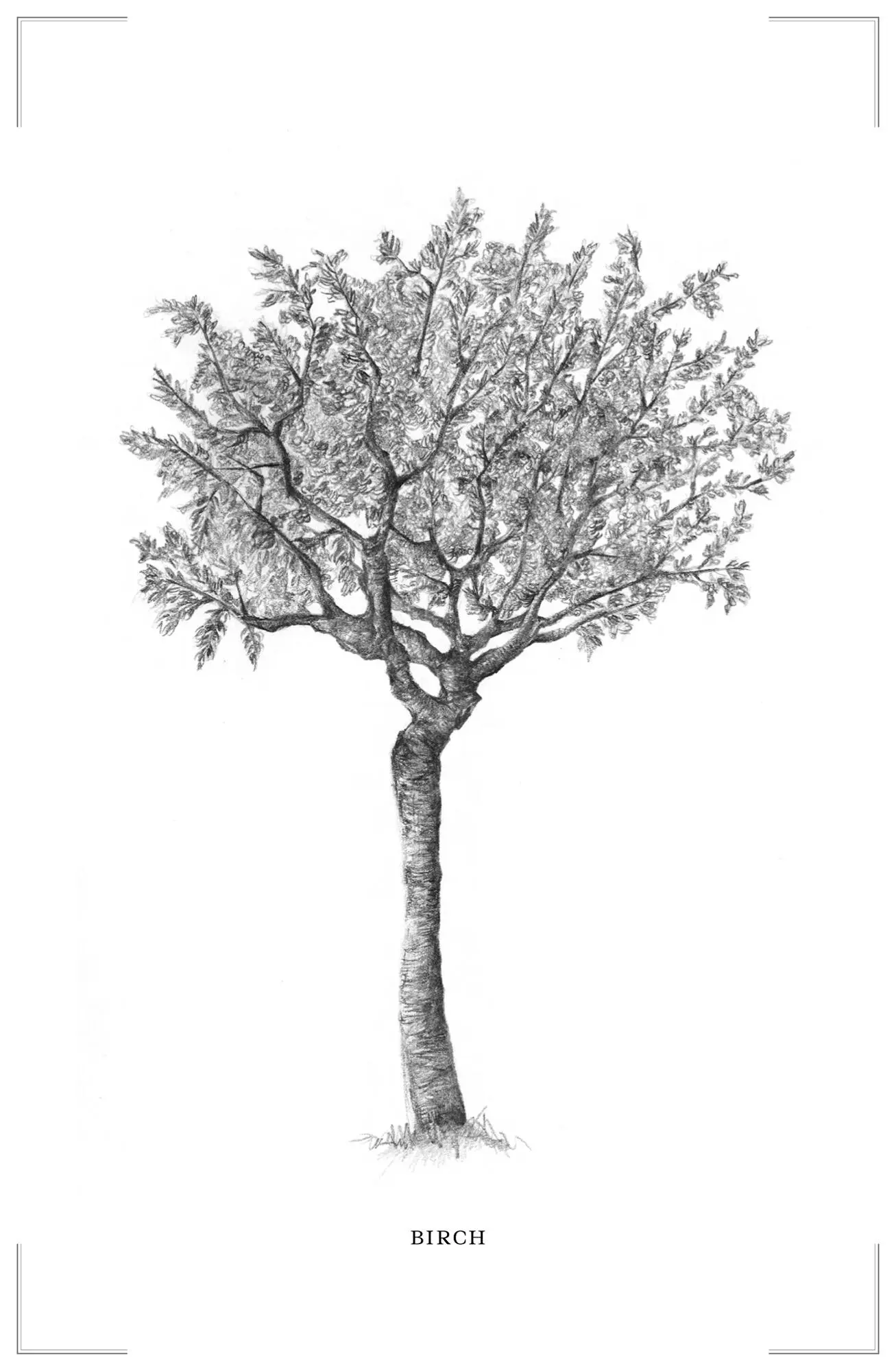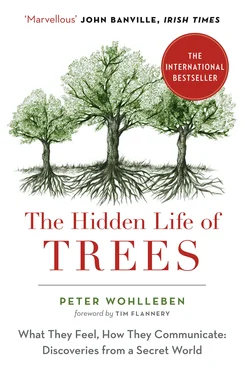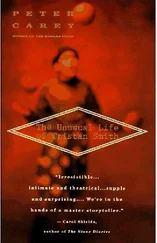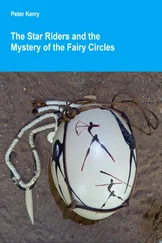About twenty years ago, I began to organize survival training and log-cabin tours for tourists. Then I added a place in the forest where people can be buried as an alternative to traditional graveyards, and an ancient forest preserve. In conversations with the many visitors who came, my view of the forest changed once again. Visitors were enchanted by crooked, gnarled trees I would previously have dismissed because of their low commercial value. Walking with my visitors, I learned to pay attention to more than just the quality of the trees’ trunks. I began to notice bizarre root shapes, peculiar growth patterns, and mossy cushions on bark. My love of Nature—something I’ve had since I was six years old—was reignited. Suddenly, I was aware of countless wonders I could hardly explain even to myself. At the same time, Aachen University (RWTH Aachen) began conducting regular scientific research programs in the forest I manage. During the course of this research, many questions were answered, but many more emerged.
Life as a forester became exciting once again. Every day in the forest was a day of discovery. This led me to unusual ways of managing the forest. When you know that trees experience pain and have memories and that tree parents live together with their children, then you can no longer just chop them down and disrupt their lives with large machines. Machines have been banned from the forest for a couple of decades now, and if a few individual trees need to be harvested from time to time, the work is done with care by foresters using horses instead. A healthier—perhaps you could even say happier—forest is considerably more productive, and that means it is also more profitable.
This argument convinced my employer, the community of Hümmel, and now this tiny village in the Eifel mountains will not consider any other way of managing their forest. The trees are breathing a collective sigh of relief and revealing even more of their secrets, especially those stands growing in the newly established preserves, where they are left completely undisturbed. I will never stop learning from them, but even what I have learned so far under their leafy canopy exceeds anything I could ever have dreamed of.
I invite you to share with me the joy trees can bring us. And, who knows, perhaps on your next walk in the forest, you will discover for yourself wonders great and small.

1 1 / Friendships 2 / The Language of Trees 3 / Social Security 4 / Love 5 / The Tree Lottery 6 / Slowly Does It 7 / Forest Etiquette 8 / Tree School 9 / United We Stand, Divided We Fall 10 / The Mysteries of Moving Water 11 / Trees Aging Gracefully 12 / Mighty Oak or Mighty Wimp? 13 / Specialists 14 / Tree or Not Tree? 15 / In the Realm of Darkness 16 / Carbon Dioxide Vacuums 17 / Woody Climate Control 18 / The Forest as Water Pump 19 / Yours or Mine? 20 / Community Housing Projects 21 / Mother Ships of Biodiversity 22 / Hibernation 23 / A Sense of Time 24 / A Question of Character 25 / The Sick Tree 26 / Let There Be Light 27 / Street Kids 28 / Burnout 29 / Destination North! 30 / Tough Customers 31 / Turbulent Times 32 / Immigrants 33 / Healthy Forest Air 34 / Why Is the Forest Green? 35 / Set Free 36 / More Than Just a Commodity Note from a Forest Scientist by Dr. Suzanne Simard Notes Index Acknowledgments About the Publisher
— FRIENDSHIPS — 1 / Friendships 2 / The Language of Trees 3 / Social Security 4 / Love 5 / The Tree Lottery 6 / Slowly Does It 7 / Forest Etiquette 8 / Tree School 9 / United We Stand, Divided We Fall 10 / The Mysteries of Moving Water 11 / Trees Aging Gracefully 12 / Mighty Oak or Mighty Wimp? 13 / Specialists 14 / Tree or Not Tree? 15 / In the Realm of Darkness 16 / Carbon Dioxide Vacuums 17 / Woody Climate Control 18 / The Forest as Water Pump 19 / Yours or Mine? 20 / Community Housing Projects 21 / Mother Ships of Biodiversity 22 / Hibernation 23 / A Sense of Time 24 / A Question of Character 25 / The Sick Tree 26 / Let There Be Light 27 / Street Kids 28 / Burnout 29 / Destination North! 30 / Tough Customers 31 / Turbulent Times 32 / Immigrants 33 / Healthy Forest Air 34 / Why Is the Forest Green? 35 / Set Free 36 / More Than Just a Commodity Note from a Forest Scientist by Dr. Suzanne Simard Notes Index Acknowledgments About the Publisher
YEARS AGO, I stumbled across a patch of strange-looking mossy stones in one of the preserves of old beech trees that grows in the forest I manage. Casting my mind back, I realized I had passed by them many times before without paying them any heed. But that day, I stopped and bent down to take a good look. The stones were an unusual shape: they were gently curved with hollowed-out areas. Carefully, I lifted the moss on one of the stones. What I found underneath was tree bark. So, these were not stones, after all, but old wood. I was surprised at how hard the “stone” was, because it usually takes only a few years for beechwood lying on damp ground to decompose. But what surprised me most was that I couldn’t lift the wood. It was obviously attached to the ground in some way.
I took out my pocketknife and carefully scraped away some of the bark until I got down to a greenish layer. Green? This color is found only in chlorophyll, which makes new leaves green; reserves of chlorophyll are also stored in the trunks of living trees. That could mean only one thing: this piece of wood was still alive! I suddenly noticed that the remaining “stones” formed a distinct pattern: they were arranged in a circle with a diameter of about 5 feet. What I had stumbled upon were the gnarled remains of an enormous ancient tree stump. All that was left were vestiges of the outermost edge. The interior had completely rotted into humus long ago—a clear indication that the tree must have been felled at least four or five hundred years earlier. But how could the remains have clung onto life for so long?
Living cells must have food in the form of sugar, they must breathe, and they must grow, at least a little. But without leaves—and therefore without photosynthesis—that’s impossible. No being on our planet can maintain a centuries-long fast, not even the remains of a tree, and certainly not a stump that has had to survive on its own. It was clear that something else was happening with this stump. It must be getting assistance from neighboring trees, specifically from their roots. Scientists investigating similar situations have discovered that assistance may either be delivered remotely by fungal networks around the root tips—which facilitate nutrient exchange between trees 1—or the roots themselves may be interconnected. 2In the case of the stump I had stumbled upon, I couldn’t find out what was going on, because I didn’t want to injure the old stump by digging around it, but one thing was clear: the surrounding beeches were pumping sugar to the stump to keep it alive.
If you look at roadside embankments, you might be able to see how trees connect with each other through their root systems. On these slopes, rain often washes away the soil, leaving the underground networks exposed. Scientists in the Harz mountains in Germany have discovered that this really is a case of interdependence, and most individual trees of the same species growing in the same stand are connected to each other through their root systems. It appears that nutrient exchange and helping neighbors in times of need is the rule, and this leads to the conclusion that forests are superorganisms with interconnections much like ant colonies.
Of course, it makes sense to ask whether tree roots are simply wandering around aimlessly underground and connecting up when they happen to bump into roots of their own kind. Once connected, they have no choice but to exchange nutrients. They create what looks like a social network, but what they are experiencing is nothing more than a purely accidental give and take. In this scenario, chance encounters replace the more emotionally charged image of active support, though even chance encounters offer benefits for the forest ecosystem. But Nature is more complicated than that. According to Massimo Maffei from the University of Turin, plants—and that includes trees—are perfectly capable of distinguishing their own roots from the roots of other species and even from the roots of related individuals. 3
Читать дальше













